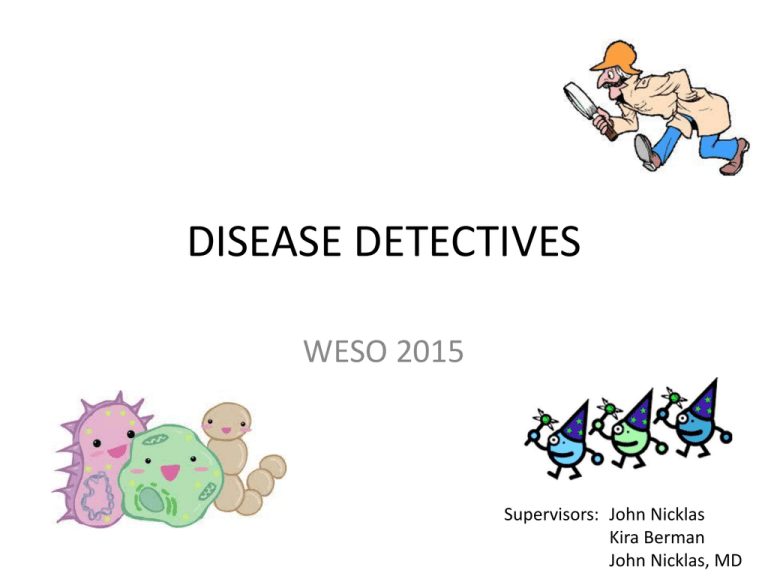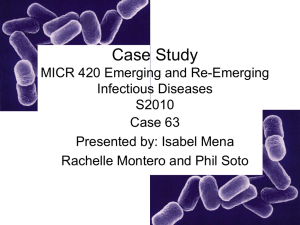
DISEASE DETECTIVES
WESO 2015
Supervisors: John Nicklas
Kira Berman
John Nicklas, MD
Brief Description
Objective: The goal of the Disease Detectives event is to have
students make connections between things that they may
encounter in daily life and risks for disease and injury, and
opportunities for prevention. In addition students should
understand specific community health problems.
Brief description: Students will be tested on their knowledge,
observational, analytical, and investigative skills in the study of
disease, risk, spread, and prevention in populations or groups of
people with a focus on population growth causes of public
health problems.
2015 Focus: POPULATION GROWTH
Public Health Problems Related to
Population Growth
•
•
•
•
•
Water Quality and Water Pollution
Sanitation Needs
Air Pollution
Environmental Degradation
Rapid Spread of Disease via Public Transportation
and Air Travel
• Food Quality and Food Contamination
• People moving into uninhabited areas, new
pathogens
The Competition
Grades: 2, 3, 4 and 5
Number of participants: up to 3 students
Time: 30 mins
•
•
•
•
•
•
Test format: A team of 1-3 students will be tested through a written test, analysis
of material at observation tables, or a combination of both.
Question format: The question format may include, but not be limited to multiple
choice questions, fill in the blanks, true or false, matching, and/or short answers.
All questions will be grade appropriate. Any calculations and mathematical
manipulations will be consistent with grade level math skills. Students do not need
to show their work.
Observation table format: Students may observe an object, a picture, a table, a
graph, a diagram, narrative information, and/or a short video. There will be
specified questions in the test regarding the material presented.
Event parameters: A standard #2 pencil, lined notepaper, and answer sheets will
be provided by the supervisor. Grades 2 and 3 will NOT need calculators. WESO
will provide Grades 4 and 5 with a calculator (non-graphing, nonprogrammable). A
reference sheet will not be allowed.
Scoring: Each test question will be assigned a point value to be earned by teams
answering correctly. The highest number of points will determine the winner.
Tie Breaker: Pre-selected test questions will be used as tiebreakers.
About this PowerPoint
• This is just a study guide; it does not include all
the necessary information students will need to
know.
• Everything that applies only to 4th and 5th
Graders is labeled as such on the slide. All other
slides are meant for all grades.
• (Grades 4 and 5) The emphasis this year is on
concepts (such as epi-curves and cohort/case
control studies), not on memorizing information
(general and specific pathogens).
STUDY GUIDE FOR DISEASE DETECTIVES 2015
What EVERYONE Needs To Know:
•
•
•
•
•
•
•
•
Role and Examples of Disease Detectives
Outbreak Investigation (Scientific Method)
Problems investigated by Disease Detectives
Basic Epidemiological Terms
Types of Pathogens
Modes of Transmission – Agent/Host/Environment
Risk Factors - Time/Person/Place
Interpreting simple data: narrative, tables, charts,
maps, graphs (bar and line)
• Control, Treatment, and Prevention Strategies
STUDY GUIDE FOR DISEASE DETECTIVES 2015
Extra Stuff for 4th and 5th Graders:
•
•
•
•
•
•
Define and Identify Cases
Make a Table from a Line Listing
Cohort vs. Case Control - Analytical Studies
Calculate Measures of Risk
Analyze an Epi Curve
Characteristics of Specific Pathogens
Role of Disease Detectives
Who are Disease detectives?
Epidemiologists, medical professionals (physicians,
veterinarians, nurses), laboratory scientists, statistician,
environmental specialists.
Role of a disease detective?
Collecting and comparing data on various diseases or
infections within communities – health of populations,
not individuals.
Definition and Role of:
EPA - Environmental Protection Agency (USEPA)
CDC – Centers for Disease Control and Prevention
Scientific Method as Related to Disease Detectives
Students need to be familiar with the steps and their importance:
(Grades 2 & 3: understand; Grades 4 & 5: understand and apply)
1.
2.
Obtain Background Information
Define the Problem (and confirm its existence by proper diagnosis
in case of an infection)
3. Formulate Hypothesis (for infectious agents:
agent/host/environment triad = chain of transmission. Agent
capable of causing disease + persons susceptible to agent +
environment allowing them to get together)
4. Develop a Study to Test the Hypothesis
5. Collect Data and Observations
6. Evaluate Results
7. Determine if Hypothesis is true/modify
8. Formulate Conclusions
9. Implement Control and Preventative Measures
10. Report Results
Problems Investigated by a Disease Detective
• chronic diseases
– asthma, heart disease, cancer, diabetes…
• environmental problems
– allergies, air and water pollution, radiation,
lead, mercury, climate change…
• behavioral problems
– obesity, stress, lack of sleep…
• injuries
– violence, occupation, sports…
– transportation accidents
• infectious diseases
– bacterial, viral, parasitic, prion…
Basic Epidemiological Terms
Grades 2 and 3: agent, case report, case series, chain of
infection, cluster, contamination, endemic, environment,
epidemic, epidemiology, fomite, gram stain, host,
hygiene, immunity, infection, infectious, outbreak,
outcome, pandemic, pathogen, pathogenic, pattern,
public health surveillance, risk, susceptible, symptom,
trend, vector, vehicle, virulent.
Grades 4 and 5: attack rate, case control, cohort, control
group, epi curve, exposure, incidence, incubation, index
case, infectivity, mortality, odds ratio, onset, prevalence,
relative risk, reservoir, virulence, zoonosis, AND Grade
2/3 terms.
Types of Pathogens
•
•
•
•
•
•
•
viruses
bacteria
protists (protozoa)
fungi
animals (worms)
natural toxins, chemicals
prions
Basic characteristics: definition of pathogen type, structure, morphology,
gram stain, motility, habitat, any unique features.
Additional Information for Grades 4 & 5 only:
• Escherichia coli, Campylobacter jejuni, Vibrio cholerae, Giardia intestinalis,
Ebolavirus, Norovirus, and Borrelia burgdorferi
• Growth requirements, diet, route of entry
• Symptoms, incubation period, virulence, infectivity, treatments, vaccines
• Common mode of transmission, recent outbreaks.
Example of info needed for a general pathogen:
Bacteria
Definition
Prokaryotic, unicellular microorganisms.
Structure
Have cell walls but lack organelles and an organized nucleus.
Morphology /
Types
Typically .5 to 5.0 µm. Can be spherical (cocci), rod-shaped (bacilli), comma
(vibrio), or spiral (spirilla). Arranged in pairs (di), lines (strep), or clusters (staph).
Identification
Looks like:
Motility
Flagella – swim through fluids. Bacterial gliding, twitching motility – move
across surfaces.
Habitat
Practically everywhere: our guts, soil, water, acidic hot springs, radioactive
waste, the deep portions of Earth's crust.
Common
Examples
E. Coli, V. Cholerae, C. jejuni, Salmonella, Tuberculosis, Streptococcus, Pertussis,
Borrelia.
Unique
Features
Reproduce by binary fission, can be divided into gram positive and gram
negative based on cell membrane.
Destroy
Heat/cold, antibiotics, silver, chlorine, bleach.
Diet
Sunlight, inorganic compounds, organic compounds, CO2.
or
Route of Entry Oral, respiratory, open wound, bodily fluids.
DON’T LEARN
All two-dozen phyla or two hundred genera of bacteria.
Modes of Transmission
Contact:
• Direct
• Indirect
• Droplet
Non-contact:
• Airborne
• Vehicle (foodborne)
• Vector
Agent/Host/Environment Triad
• Agent
– pathogen & its source
• Host
– persons susceptible to agent
• Environment
– allows them to get together
Define and Identify Cases (4th and 5th Grade)
Case definition – establish the standard criteria for determining
who has the disease or condition – who’s in this outbreak?
• Clinical information – about the disease or condition
• Characteristics - of the affected people
• Location or place - as specific as possible as restaurant, county, or
geographic area
• Time sequence - specific time during which the outbreak or condition
occurred
Identification of cases – kind & number – count specific cases
• Confirmed – have diagnosis with case definition plus lab verification
• Probable – many factors point to diagnosis but may lack lab verification
• Possible – some factors point to diagnosis
Note: Initial reports may be only a small sampling of the total problem. Be
sure to expand search to determine the true size and extent of the problem.
Make a Table from a Line Listing (4th and 5th Grade)
• Line Listing – list of all the patients in outbreak, with
all the relevant information included.
• Ex: twelve case report forms on a E. Coli outbreak.
ID # Initials Date
of Onset
1 KR
7/24
2 DM
7/27
3 JG
7/28
4 RD
7/25
5 NT
7/29
6 AM
7/27
7 JR
7/24
8 IH
7/25
9 TJ
7/31
10 AT
7/28
11 ML
7/29
12 DU
7/30
Diagnosis
Confirmed
E. Coli
E. Coli
E. Coli
E. Coli
E. Coli
No E. Coli
E. Coli
No E. Coli
No E. Coli
E. Coli
No E. Coli
No E. Coli
Turn this Line Listing into:
Age
Sex
County
Physician
Wedding
29
33
26
45
27
54
39
41
49
26
36
50
M
M
M
M
F
F
M
F
F
F
M
F
Columbia
Columbia
Columbia
King
Columbia
Clayton
Clayton
King
Clayton
Columbia
King
Columbia
Goodman
Baker
Gibbs
Webster
Stanley
Mason
Smith
Gewertz
Koller
Kapur
Mohr
Kaminski
Yes
Yes
Yes
Yes
Yes
Yes
No
Yes
No
Yes
No
No
E. Coli
No E. Coli
Exposed (at wedding)
6
2
Unexposed (not at wedding)
1
3
Risk Factors: Time/Place/Person
Epidemiologic variables: can be observed and/or measured.
• Time - the time of illness or of a relevant event.
Examples: date of exposure or onset of illness.
• Place - the environment in which illness occurs.
Examples: place of residence, of work, suspected exposure.
• Person - individuals who are infected, ill, or at risk.
Examples: age, gender, occupation, high risk condition (AIDS).
Look at Possible Risk Factors – Descriptive Studies: (4th and 5th Grade)
Analyze distribution of disease by cases or outcome, frequency in population,
exposure, time pattern or environmental factor.
• Case report/case series
– case report = single patient, case series = several patients
• Correlative studies
– Time series - same population at different times
– Ecologic relations - specific ecologic factors
– Cross sectional – survey: participants are selected irrespective of exposure/disease status
Data Table
EXAMPLE of a simple narrative with a 2 X 2 table format for all grades:
An earthquake struck a town of 400 people and destroyed their sanitation system.
Some persons became ill. The suspected source was a well near a ruptured sewer line.
The town’s population was then surveyed to determine who became ill.
Sick
Not Sick
Exposed (drank water from well)
150
30
Unexposed (did not drink water)
50
170
Total number of people in the town? 400
Number of people who were exposed to the well water? 150 + 30 = 180
Number of people who were not exposed to the well water? 50 + 170 = 220
Number of people who were exposed to the well water and became ill? 150
•
•
•
•
•
Cohort
First divides a group by
exposure status, then sees
who got sick.
Retrospective: (historic
cohort) starts at exposure in
past & moves forward to
outcome.
Prospective: starts at present
exposure and moves forward
in time to outcome.
Calculate: attack rate and
relative risk
Ex: To determine the
effectiveness of influenza
vaccines in the elderly, groups
of vaccinated and
unvaccinated elderly people
were studied.
(4th and 5th Grade)
vs.
Case Control
• Works backward from effect
or illness to suspected cause.
• Control group has similar
characteristics to the sick
group but is not ill.
• They are then checked for
similar exposures – hard to do
retrospectively.
• Calculate: odds and odds
ratio
• Ex: This study looked at heart
attack victims and compared
their former smoking habits
to those of individuals who
did not have heart attacks.
Calculating Measures of Risk: Cohort
(4th and 5th Grade)
An earthquake struck a town of 400 people and destroyed their sanitation system. Some persons
became ill. The suspected source was a well near a ruptured sewer line. The town’s population was
then surveyed to determine who became ill.
Sick
Not Sick
Exposed (drank water from well)
150 (a)
30
Unexposed (did not drink water)
50 (c)
170 (d)
(b)
Attack rate (4th and 5th grades): the rate that a group experienced an illness. (Look for high attack
rate in exposed & low rate in unexposed) = number of people sick ÷ total in that group.
Attack rate for exposed individuals = 150 ÷ 180 = 0.833 (83.3%)
a/(a+b)
Attack rate for unexposed individuals = 50 ÷ 220 = 0.227 (22.7%) c/(c+d)
Relative risk (5th grade): estimates the extent of the association between an exposure and a
disease. It estimates the likelihood of developing the disease in the exposed group as compared to
the unexposed group.
A relative risk > 1.0 indicates a positive association or an increased risk.
A relative risk = 1.0 indicates that the incidence rates of disease in the exposed group is equal to
the incidence rates in unexposed group. Therefore the data does not provide evidence for an
association.
Relative risk = Attack rate for exposed ÷ Attack rate for unexposed = 83.3% ÷ 22.7% = 3.66.
[a/(a+b)]/[c/(c+d)]=a(c+d)/c(a+b)
Calculating Measures of Risk: Case-Control
(4th and 5th Grade)
200 people arrived at the emergency room, all complaining of severe stomach cramps. The
suspected cause was contaminated jello-pudding served at a recent dinner party. A control group
was then found from among those dinner party guests who did not become ill.
Disease Yes (cases)
Disease No (controls)
Exposed (ate jello)
150
(a)
80
(b)
Unexposed (no jello)
50
(c)
20
(d)
Odds (4th and 5th grades): the odds that a certain group was exposed to a risk factor. = number of
people exposed ÷ number of people unexposed
Odds for cases = 150 ÷ 50 = 3
a/c
Odds for controls = 80 ÷ 20 = 4
b/d
Odds Ratio (5th grade): It estimates how many times more likely those who were exposed were to
develop disease.
Odds for cases ÷ odds for controls = 3/4 = 0.75.
[a/c]/[b/d]=ad/bc
Therefore, those who ate jello were 0.75 times as likely than those who didn’t eat jello to get sick,
or in other words less likely. The real cause of the outbreak was something else.
Epi- Curves
(4th and 5th Grade)
• An epi-curve is a histogram, displaying frequency
of disease on the y-axis and time on the x-axis
(units ≈¼ of incubation period).
• It can tell us about:
–
–
–
–
–
Pattern of spread
Magnitude
Outliers
Time trend
Exposure and/or disease incubation period
• Students won’t be asked to create epi-curves, but
will be asked to interpret epi-curves.
Analyzing Epi- Curves (4th and 5th Grade)
Outlier: Index Case
Minimum Incubation Period: 7 days
Average Incubation Period: 10 days
Likely Period of Exposure: 3 days
Magnitude: 73 cases total
Time Trend: First case on Day 11, peak # of cases on Day 21, no cases after Day 28
Epi- Curves – Patterns of Disease Spread (4th and 5th Grade)
(one-time exposure)
(person-to-person)
Graphs
EXAMPLE of a Bar Graph:
Pertussis Infection by 5-Year Age Groups (www.cdc.gov)
Which age group has the largest number of cases? 0-4
True or False: As you grow older, the risk of pertussis infection decreases.
(True)
Line Graphs
EXAMPLE of a Line graph: www.cdc.gov
How many TB cases were there in the United
States in 2001?
a. About 10,000
b. About 25,000
c. About 16,000
d. Cannot tell from the Figure
Answer: c
Which of the following statements is false?
a. There were more Tuberculosis (TB) cases in
1993 than in 1984.
b. For the years shown in the Figure, the year
with the fewest TB cases was 2001.
c. For the years shown in the Figure, the only
year when there were fewer than 20,000
TB cases was 1999.
Answer: c
Control and Prevention Strategies
1. Act as soon as source is known – people are sick or hurting and
need help; must know agent & source of agent + susceptibility of
host + chain of transmission
2. Aim at chain of agent-source-host – break the chain of
transmission at any of its 3 points
3. Interrupt transmission or exposure – isolate vehicles of
transmission
4. Reduce susceptibility – with immunization and education
Specific Illnesses (4th and 5th Grade)
4th and 5th Grade: specific questions can be based on the following illnesses:
•
•
•
•
•
•
•
Escherichia coli (E. coli)
Campylobacter jejuni (C. jejuni)
Vibrio cholerae (V. cholerae)
Giardia intestinalis (G. intestinalis)
Norovirus
Borrelia burgdorferi
Ebolavirus
Study criteria: type of causative agent, basic characteristics, mode of
transmission, foods most associated with the illness, any unique features,
symptoms, diagnosis, prevention, treatment, identification, gram stain,
incubation period, virulence, infectivity, recent outbreaks, history.
(4th and 5th Grade)
An example of information needed for a specific illness:
E. coli (Shiga toxin E. coli infection or STEC infection)
http://www.cdc.gov/foodsafety/diseases/
Agent
Bacteria ( E. coli), rod shaped, gram negative
General info
Normally live in the intestines of people and ruminant animals,
(including cattle, goats, sheep, deer, and elk); an important part of
a healthy human intestinal tract; Most are harmless but some are
pathogens.
Transmission The major source for human illnesses is cattle; Consumption of
contaminated food (with human or animal feces), consumption of
unpasteurized (raw) milk, consumption of water that has not been
disinfected, contact with cattle, or contact with the feces of infected
people.
Associated
These foods include unpasteurized (raw) milk, unpasteurized
high risk foods apple cider, and soft cheeses made from raw milk.
Unique
Produces shiga toxin; These bacteria that cause human illness
features
generally does not make animals sick; incubation period of 3-4
days.
People at risk People of any age can become infected; At risk: very young children
and the elderly.
(4th and 5th Grade)
An example of information needed for a specific illness:
E. coli (Shiga toxin E. coli infection or STEC infection)
http://www.cdc.gov/foodsafety/diseases/
Symptoms Vary for each person but often include severe stomach cramps,
diarrhea (often with blood), vomiting and sometimes fever.
Diagnosis Laboratory test of stool (feces) samples for the presence of Shiga
toxins.
Treatment Hydration, antibiotics have not been helpful.
Prevention Wash your hands thoroughly after using the bathroom or changing diapers
and before preparing or eating food.
Wash your hands after contact with animals or their environments (at
farms, petting zoos, fairs, even your own backyard).
Cook meats thoroughly.
Avoid raw milk, unpasteurized dairy products, and unpasteurized juices
(like fresh apple cider).
Avoid swallowing water when swimming or playing in lakes, ponds,
streams, swimming pools, and backyard “kiddie” pools.
Prevent cross contamination in food preparation areas by thoroughly
washing hands, counters, cutting boards, and utensils after they touch raw
meat.
Useful Links
• National Science Olympiad - http://www.soinc.org/disease_detectives_b
The focus is on the training handout/PowerPoint, but the test will not cover
everything on this sheet. Make sure that the info is grade-level appropriate
and the topic is covered in this PowerPoint before handing the info out.
• Practice Tests http://scioly.org/wiki/index.php/Test_Exchange#Disease_Detectives
Again, I won't cover everything asked on these tests. Coaches must check
to make sure that each question is grade level appropriate and covered in
the WESO DD PowerPoint/Study Guide before they hand out these exams.
• Public Health Teaching Resources - http://www.cdc.gov/excite/
Links to other sites, teaching exercises, and more. Make sure they are
grade-level appropriate and the topic is covered in this PowerPoint before
handing them out.
• (Grades 4 and 5) Cohort / Case Control http://www.fammed.ouhsc.edu/tutor/analdes.htm,
http://omerad.msu.edu/ebm/Prognosis/Prognosis3.html
The emphasis is on being able to identify a given study as either a cohort or
a case control.
Fun Links and Questions
Fun Links:
http://www.disease-detectives.org/Welcome.html
http://www.pbs.org/wgbh/nova/body/disease-detective.html
http://www.diseasedetectives.org/
http://library.thinkquest.org/06aug/01865/
ANY QUESTIONS??
Please email:
weso.science@gmail.com
Subject: Disease Detectives
HAVE FUN!!











